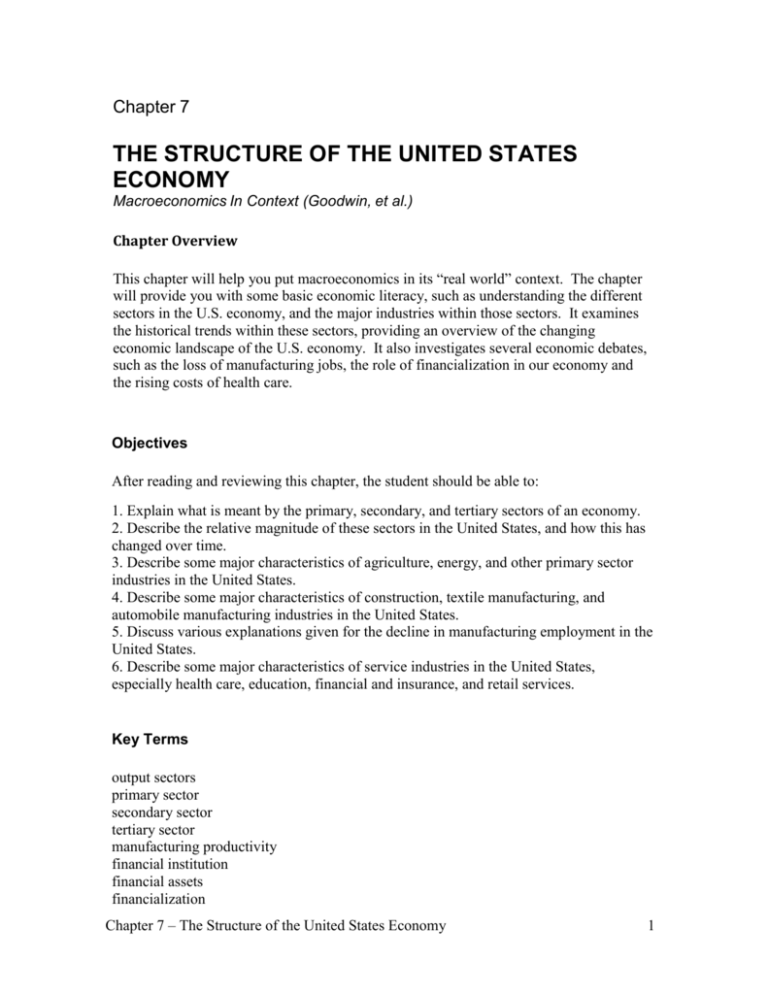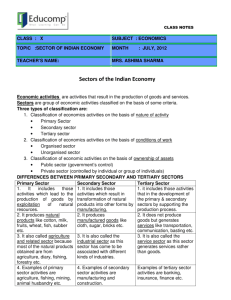the structure of the united states economy
advertisement

Chapter 7 THE STRUCTURE OF THE UNITED STATES ECONOMY Macroeconomics In Context (Goodwin, et al.) Chapter Overview This chapter will help you put macroeconomics in its “real world” context. The chapter will provide you with some basic economic literacy, such as understanding the different sectors in the U.S. economy, and the major industries within those sectors. It examines the historical trends within these sectors, providing an overview of the changing economic landscape of the U.S. economy. It also investigates several economic debates, such as the loss of manufacturing jobs, the role of financialization in our economy and the rising costs of health care. Objectives After reading and reviewing this chapter, the student should be able to: 1. Explain what is meant by the primary, secondary, and tertiary sectors of an economy. 2. Describe the relative magnitude of these sectors in the United States, and how this has changed over time. 3. Describe some major characteristics of agriculture, energy, and other primary sector industries in the United States. 4. Describe some major characteristics of construction, textile manufacturing, and automobile manufacturing industries in the United States. 5. Discuss various explanations given for the decline in manufacturing employment in the United States. 6. Describe some major characteristics of service industries in the United States, especially health care, education, financial and insurance, and retail services. Key Terms output sectors primary sector secondary sector tertiary sector manufacturing productivity financial institution financial assets financialization Chapter 7 – The Structure of the United States Economy 1 Active Review Fill in the Blank 1. The harvesting of forest products would be a component of the __________ sector. 2. Whereas the extraction of oil would fall under the ________ sector, the refining of petroleum would fall under the __________ sector. 3. Utilities, such as electricity production, are a component of the __________ sector. 4. Marketing and retailing are a component of the ______ 5. The tertiary sector is also called the ____ sector. sector. 6. The sector that dominates the U.S. economy, comprising 75% of all output, is the _____________ sector. 7. While the U.S. has less than ______ percent of the world’s population, it uses about ________ percent of the world’s energy. 8. By 2012, the U.S. imported ________ percent of its oil, most of it from the countries of _________, _________, and _____________. 9. Stocks, bonds, and money mutual funds are examples of _____________ assets. 10. The sector that dominates the U.S. economy, comprising 75% of all output, is the ____ sector. 11. Much of the non-monetized economic activity in the core sphere, if counted, would be part of the __ sector. Chapter 7 – The Structure of the United States Economy 2 True or False 11. The rudimentary processing of raw materials would fall under manufacturing in the secondary sector. 12. The products produced in the primary sector are generally sold to consumers in households. 13. The primary sector is no longer of great importance to the U.S. economy, given that it represents only about 3% of the U.S. private economy and employs only 1% of U.S. workers. 14. About 60% of the U.S. fishery stocks are being harvested at or over the maximum sustainable level. 15. The absolute number of manufacturing jobs peaked years ago in virtually all industrial countries. Short Answer 16. Briefly define the primary, secondary, and tertiary sectors. 17. How have the shares of the U.S. private economy attributed to each of the three sectors in the U.S. changed over the last few decades of the 20th century? 18. How have employment patterns in these three sectors changed since the 1960s? 19. What factor(s) explains the relative decline of the primary sector in the U.S.? 20. What are the current threats to agricultural productivity in the U.S.? Chapter 7 – The Structure of the United States Economy 3 21. How does agriculture, an activity primarily in the primary sector, spill over into the secondary and tertiary sectors? 22. Where does the U.S. get its oil from (as of 2012)? 23. Why is the manufacturing sector in the U.S. losing jobs? 24. Critics of the service sector complain that service jobs pay poorly. Is this true? 25. (In Appendix) What are the four categories of the tertiary sector in the alternative categorization developed by the authors of the textbook? What kinds of activities are included in each? 26. (In Appendix) Why have services become such a significant part of the U.S. economy? Chapter 7 – The Structure of the United States Economy 4 Problems 1. Suppose the table below represents the simple economy of Peaceland. Industry Agriculture Transportation Trade Health care and social assistance Education Construction Arts and Recreation Diplomacy & peacekeeping Textile manufacturing Waste management and environmental stewardship Economy Total Value Added (in millions of dollars) 21 34 50 21 Percent of GDP 20 44 11 80 65 54 5 11.0 2.8 20 16.3 13.5 400 100% 5.3 8.5 12.5 5.3 a. Determine the size of the primary sector (in terms of value added and percent of GDP). b. Determine the size of the secondary (in terms of value added and percent of GDP). c. Determine the size of the tertiary sector (in terms of value added and percent of GDP). 2. Suppose the simple economy of Peaceland, above, has decided to cut out some of the activities of the “middlemen” – the people and organizations that are involved in moving products from the producer to the final consumer. They have set up Fair Trade initiatives and have established local farmers’ markets, in order to encourage more of the value of the product to flow directly to the producer, rather than flowing into the pockets of the middlemen. Suppose the table below represents the simple economy of Peaceland after these changes. Chapter 7 – The Structure of the United States Economy 5 Industry Agriculture Transportation Trade Health care and social assistance Education Construction Arts and Recreation Diplomacy & peacekeeping Textile manufacturing Waste management and environmental stewardship Economy Total Value Added (in millions of dollars) 21 25 30 21 Percent of GDP 24 44 11 80 65 54 6.4 11.7 2.9 21.3 17.3 14.4 375 100% 5.6 6.7 8 5.6 Determine the size of the primary, secondary, and tertiary sectors, in terms of percent of GDP. How have the respective sizes changed compared to your answer in problem 1? 3. The oil (petroleum) industry plays an important role in our economy. Using the supply and demand model from Chapter 4, determine how each of the following events would affect the price of oil on the world market. Identify if the event would cause a shift in supply or a shift in demand (ceteris paribus), in which direction, and whether the equilibrium price of oil would increase or decrease. a. OPEC engages in an oil embargo in 1973 b. Consumers in the U.S. and Europe start driving more fuel efficient cars in the late 1970s and early 1980s c. Saudi Arabia departs from the OPEC agreement and increases its supply of oil in the early 1980s d. Consumers in the U.S. start driving more fuel inefficient SUVs and light trucks with low gas mileage in the 1990s e. The economies of China and India grow more rapidly in the early 2000s and consumers buy and drive more cars f. Oil production in Iraq, one of the three countries with the largest reserves of oil, is disrupted after the U.S.-led war, invasion and occupation Chapter 7 – The Structure of the United States Economy 6 Self Test 1. How large is the U.S. economy? a. b. c. d. e. The largest in the world. The second largest in the world, after China. The third largest in the world, after China and India. The fourth largest in the world, after China, India and Japan. The fifth largest in the world, after China, India, Japan, and Germany. 2. Which of the following would be a primary sector activity? a. b. c. d. e. Utilities Construction The selling of houses A household growing food in their garden A household whose members clean their house 3. Which of the following would not be an activity in the primary sector? a. b. c. d. e. Agriculture Commercial fishing Mining The timber industry The food processing industry 4. Maria is a farmworker. Jose is a medical doctor. Robin is a construction worker. Which of them works in the secondary sector? a. b. c. d. e. Maria Jose Robin All of them do. None of them do. 5. Which of the following would not be an activity of the secondary sector? a. b. c. d. e. Automobile manufacturing Utilities Construction Food processing Transportation of goods to market Chapter 7 – The Structure of the United States Economy 7 6. Sami works on an oil rig. Luis works at an oil refinery. Indira works as a gas station attendant. Which of them works in the tertiary sector? a. b. c. d. e. Sami Luis Indira All of them do None of them do 7. Which of the following would not be an activity of the tertiary sector? a. b. c. d. e. Cooking home-cooked meals Home construction and renovation Education Services provided by the Red Cross Firefighting services 8. Which of the following best characterizes the historical trends of the secondary sector and its share of the U.S. private economy? a. The share of the secondary sector continued to grow steadily throughout the 20th century. b. The share of the secondary sector started to decline in the early 1980s with the growth of globalization. c. The share of the secondary sector started to decline in the late 1960s. d. The share of the secondary sector started to decline in the Great Depression of the 1930s. e. None of the above. 9. Which of the following best captures how “value added” is distributed among the sectors? a. b. c. d. e. 3% in the primary sector, 64% in the secondary sector. 64% in the secondary sector, 17% in the tertiary sector. 64% in the primary sector, 17% in the tertiary sector. 3% in the primary sector, 64% in the tertiary sector. 64% in the primary sector, 17% in the secondary sector. 10. Which of the following is not one of the trends in agriculture in the U.S.? a. The total farm population has declined. b. The total number of farms has decreased. c. The average farm size has decreased. d. Output per acre has increased. e. Output per worker has increased. Chapter 7 – The Structure of the United States Economy 8 11. Which of the following is not one of the characteristics of agriculture in the U.S.? a. b. c. d. e. Farms occupy about 42% of the land area in the U.S. There are about 2 million farms in the U.S. About 92% of the farms are small family farms. Large corporate farms account for almost half of the value of agricultural output. Almost all farm receipts come from selling crops. 12. Which of the following about energy in the U.S. is false? As of 2012, the U.S. is the world’s largest consumer of energy. As of 2012, the U.S. is the world’s largest producer of energy. The U.S. has one of the highest per capita energy usage rates in the world. The U.S. has one of the highest energy efficiency rates (energy used per dollar of GDP) in the world. e. The U.S. is heavily dependent on carbon-based fossil fuels for its energy use. a. b. c. d. 13. Which of the following accurately describes energy consumption in the United States? a. b. c. d. e. In percentage terms, natural gas is the biggest category of consumption. In percentage terms, coal is the biggest category of consumption. In percentage terms, nuclear power is the biggest category of consumption. Over 80% of energy consumed in the U.S. comes from fossil fuels. None of these are accurate. 14. “Fracking” is … a. a non-toxic technique used to boost oil and gas production using water. b. a relatively new technology that has the potential to dramatically boost biomass production. c. a cutting-edge technology under development in places like France to reduce their dependence on foreign oil. d. only useful for extracting oil and gas deposits relatively close to the surface. e. none of the above. 15. Which of the following regarding trends in manufacturing is true? a. The value of manufacturing output has remained fairly constant since 1960. b. Employment in manufacturing has declined by about 30% since 1980, employing about 10% of all workers today. c. The number of workers in manufacturing declined from about 20 million in 1980 to about 14 million today. d. All of the above e. B and C only Chapter 7 – The Structure of the United States Economy 9 16. Which of the following explanations for the decline in employment in U.S. manufacturing is true? a. b. c. d. e. Americans are demanding fewer manufactured goods. Americans are demanding more manufactured goods produced abroad. Advances in productivity have enabled more output to be produced by fewer workers. All of the above B and C only 17. What factor helped boost employment in U.S. automobile manufacturing, after the employment decline in the 1970s? a. Foreign producers have a cost disadvantage of shipping their products to the U.S. b. The greater productivity of skilled workers enabled U.S. workers to compete against lower skilled low wage workers abroad. c. Foreign companies increasingly located production facilities in the U.S. d. Falling gas prices after the 1970s oil price shocks shifted demand back to larger U.S. made vehicles. e. All of the above. 18. Which of the following about the service sector is false? a. The average pay of service sector jobs is less than the average pay of manufacturing jobs. b. Trade in services is expanding rapidly, and increased more rapidly than trade in goods between 1980 and 2011. c. Service sector jobs are more homogenous than jobs in manufacturing. d. The U.S. currently exports more services than it imports. e. None of the above. 19. Which of the following services is a U.S. export? a. A U.S. citizen uses the financial services of a bank in Switzerland. b. A German tourist comes to Disneyland for summer entertainment. c. An American student studies abroad at a British university. d. An American obtains medical attention in Mexico for a lower price than attainable in the U.S. e. None of the above. 20. Which of the following is not a financial asset as identified in the chapter? a. b. c. d. e. Stocks Bonds Foreign currencies Certificates of deposit All of these are identified as financial assets in the chapter. Chapter 7 – The Structure of the United States Economy 10 Answers to Active Review Questions 1. primary 2. primary, secondary 3. secondary 4. tertiary 5. service 6. tertiary 7. five, twenty-five 8. 40, Canada, Saudi Arabia, and Mexico. 9. financial 10. tertiary 11. False. It would fall under the primary sector. 12. False. They are generally sold as inputs to manufacturers. 13. False. The primary sector still plays an important role in the economy. 14. True. 15. True. 16. The primary sector involves the extraction and simple processing of raw materials which are sold as inputs into the production process. The secondary sector transforms these inputs into final products to consumers. The tertiary sector involves the provision of services, rather than tangible goods. 17. While the tertiary sector’s share of the private economy has grown over the last decades of the 20th century, both the primary and secondary sectors have declined. 18. Since the 1960s, employment in the secondary sector started to decline, as employment in the primary sector continued its decline. Employment in the tertiary sector increased. 19. Primarily it has been due to technological improvements, which has allowed the products of the primary sector to be obtained with fewer workers. 20. The threats include: the depletion of groundwater supplies, and soil depletion. 21. Much of the processing of food is a manufacturing activity in the secondary sector. The marketing, retailing, and provisioning of food in restaurants are service sector activities in the tertiary sector. 22. As of 2012, the U.S. imports about 60% of its oil from: Canada, Saudi Arabia, Mexico, Venezuela, and Russia. 23. The U.S. manufacturing sector is losing jobs for two reasons: manufactured products can be produced more cheaply abroad, and productivity advances (automation) are reducing the overall employment in manufacturing. 24. Yes, on average the pay of service sector jobs are lower than manufacturing, for instance. However, some service sector workers (such as doctors and lawyers) are paid very well. 25. (In Appendix) The four categories are: ownership transactions (e.g. homeownership and activities involved in ownership transfers such as: transportation, warehousing, wholesale and retail trade, and real-estate rental and leasing) managing the system (information, finance and insurance, and professional, scientific, and technical services, etc.), private social services (education, health care, and social services), and entertainment (which includes accommodation and food services). 26. (In Appendix) As our economy has become so much more complex, the service sector Chapter 7 – The Structure of the United States Economy 11 has grown to organize and manage this huge complex system, e.g. making connections between buyers and sellers, collect and processing information, etc. Answers to Problems 1. a. For the Primary sector: Industry Agriculture Primary Sector Total Value Added (in millions of dollars) 21 21 b. For the Secondary sector: Industry Value Added (in millions of dollars) Construction 44 Textile manufacturing 65 109 Secondary Sector Total c. For the Tertiary sector: Industry Transportation Trade Health care and social assistance Education Arts and Recreation Diplomacy & peacekeeping Waste management and environmental stewardship Tertiary Sector Total Percent of GDP 5.3 5.3% Percent of GDP 11.0 16.3 27.3% Value Added (in millions of dollars) 34 50 21 Percent of GDP 20 11 80 54 5 2.8 20 13.5 270 67.6% 8.5 12.5 5.3 2. Now the primary sector is 5.6% of GDP, the secondary sector is 29%, and the tertiary sector is 64.5%. The tertiary sector has declined while the primary and secondary sectors have increased in size (as percent of GDP). 3. a. Supply shifts left; the oil price rises. b. Demand shifts left; the oil price falls. c. Supply shifts right; the oil price falls. d. Demand shifts right; the oil price rises. e. Demand shifts right; the oil price rises. f. Supply shifts left; the oil price rises. Chapter 7 – The Structure of the United States Economy 12 Answers to Self Test Questions 1. 2. 3. 4. 5. 6. 7. 8. 9. 10. A D E C E C B C D C 11. E 12. D 13. D 14. E 15. D 16. E 17. E 18. C 19. B 20. E Chapter 7 – The Structure of the United States Economy 13








